TARGET ACQUISTITION WITH ELECTRIC POWERED WHEELCHAIRS
ABSTRACT
The driving characteristics of three joysticks were compared while thirteen subjects with disabilities drove an instrumented electric powered wheelchair (EPW) to nine circular targets using a Fitts law protocol. One joystick was a standard movement-sensing joystick (MSJ); the second was an isometric joystick with a fixed square algorithm (FSA), the third joystick was also isometric with a variable gain algorithm (VGA). Despite novelty, the subjects' movement times (MT) with all joysticks were similar. An ANOVA with Tukey post hoc analysis revealed that the FSA resulted in slower movement times than MSJ p<0.05. The movement times of the VGA and MSJ were statistically indistinguishable.
BACKGROUND
Independent and safe operation of an electric powered wheelchair is a crucial need for adults with severe physical disabilities. Independent mobility encourages community interaction and enables employment and education[1],[2]. One recent clinical study [3] reported that up to 40% of individuals who desire powered mobility couldn't drive safely or functionally with available commercial controls. The Human Engineering Research Laboratories has been investigating isometric joysticks as an alternative control device for several years [4],[5]. Earlier studies have demonstrated that individual, both impaired and unimpaired, rapidly accommodate to an isometric control and their EPW driving performances based on root mean square path deviation was statistically undistinguishable from conventional joysticks.
RESEARCH QUESTION
The Target Acquisition study was conducted to determine if an isometric joystick with custom algorithms could enable individuals with upper extremity disabilities to drive faster and/or more accurately than a commercially manufactured, movement-sensing joystick. This study differed from our earlier studies in that it was based on Fitts law [6], which quantifies human movement performance by combining both movement time and targeting accuracy into a single formula. Fitts law is a well recognized principle of aimed human movement.
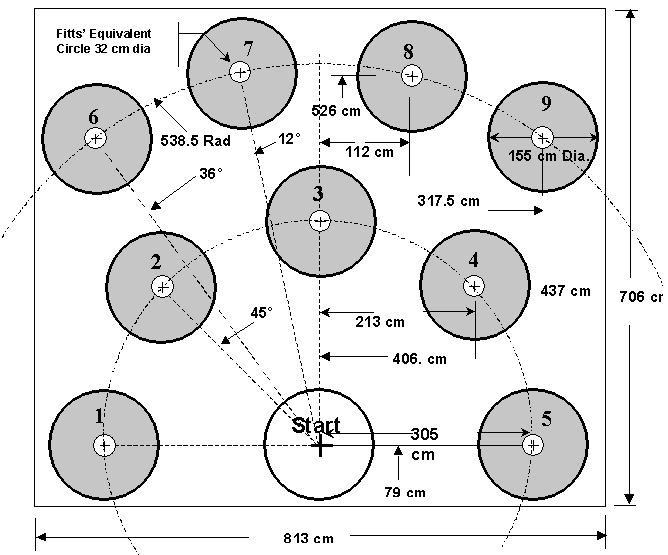 |
METHOD
Nine 155 cm circular targets were cut from black vinyl tarp material and affixed to the floor of an open laboratory space. The target diameter was calculated to be 20% larger than the diagonal length of the test EPW; which was measured from the toe of the left front footrest to back surface of the right rear wheel at axle height. (Fig 1).
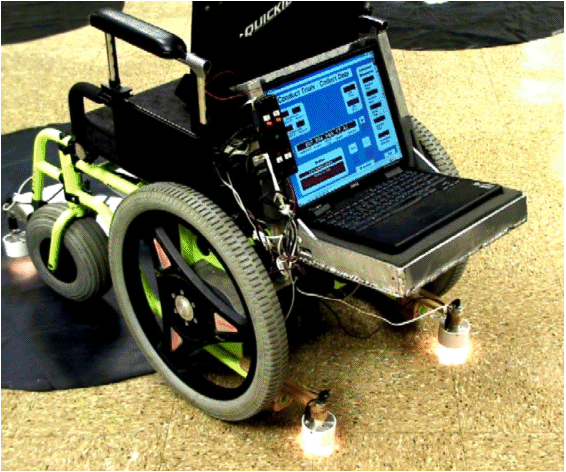 |
An instrumented Quickie P300 EPW was used for all trials. Four optical sensors with internal incandescent lighting to eliminate shadows were installed on the outer corners of undercarriage and an aluminum tray was installed to carry a laptop computer. A digital circuit monitored these sensors and signaled the computer whenever all four sensors detected a black target. Software written in Borland Builder C++ monitored the digital board and timed the driving trials (Fig 2). At the beginning of each trial, the program beeped to prompt the subject to begin driving and recorded the movement time (MT) required to reach the target. Following target acquisition, the software counted down an additional 2000 milliseconds to determine whether the subject had stopped within the target circle or rolled over the perimeter. Staying within the target circle for two seconds insured a complete halt and was recorded as a “Hit”; exiting the circle prior to two seconds was recorded as a “Miss”.
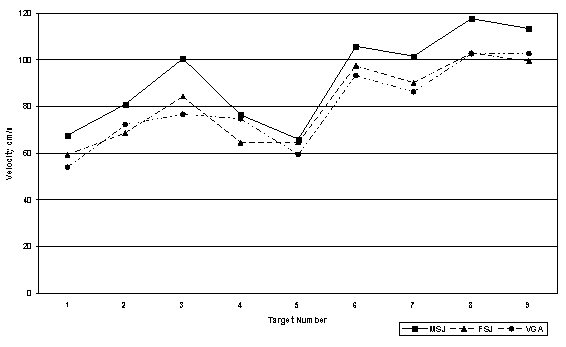 |
Subjects were daily EPW users with experience ranging from five to twenty years. Eleven of the thirteen were able to complete the protocol. Four had cerebral palsy, three had spinal cord injuries, two had traumatic brain injuries and two had neuromuscular disorders, (MD and Polio). Each subject made a single visit to our lab, gave informed consent, and operated our test chair for approximately two hours. They drove to each target three times with each joystick for a total of 81 trials. Data collected included movement time in milliseconds; only “Hits” were included in this analysis. For each subject, the mean MT was calculated for each joystick/target combination. The Mean MTs were transformed to mean velocities (cm/sec) to allow comparison of the different target distances.
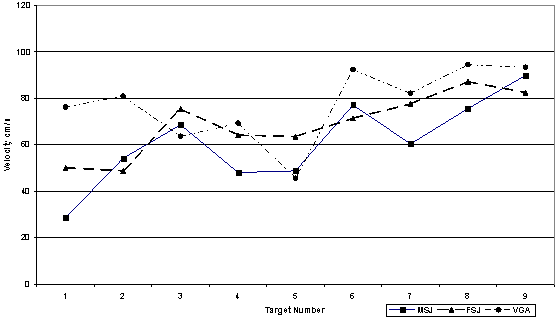 |
RESULTS
The performances of the first two subjects are illustrated in Figures 3 and 4. Subject one with SCI has a consistent pattern - lower velocities on front row targets and higher velocities on targets that required less turning. This subject performed consistently better with the MSJ. Subject two with CP displays much more variance with many of the scores with the FSA and VGA exceeding those achieved with the MSJ.
A within subjects ANOVA was run on the eleven participants who completed the protocol. Using a alpha of 0.05, a Tukey post hoc analysis revealed a significant difference between the FSJ and the MSJ controls ; the FSJ had significantly longer MTs than the MSJ. The MTs of the VGA and MSJ were statistically indistinguishable.
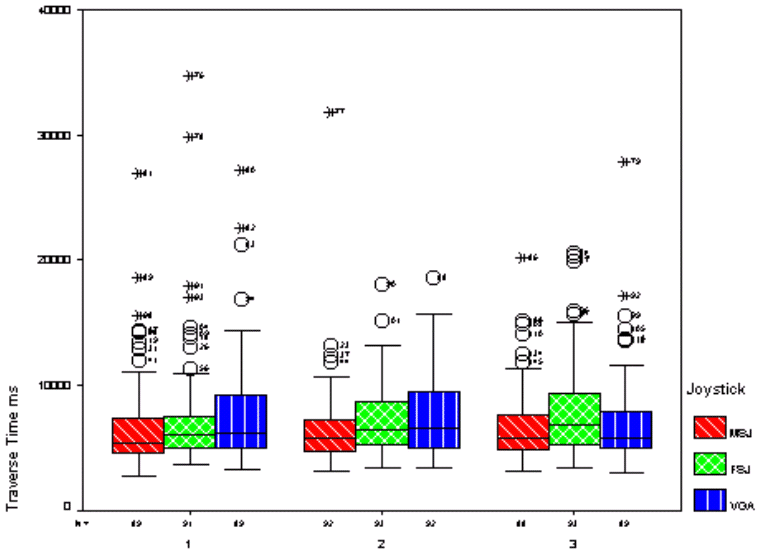 |
A boxplot graphic, Fig 5, considers the effect of practice and fatigue across the three presentations of each joystick. Visually, a trend can be observed in the data that suggests performance with the MSJ remains constant over time, performance with the FSA degrades and performance with the VGA improves to rival the MSJ by the third presentation. Although this trend is visually evident, a Kruskal-Wallis analysis on the effect of increased practice on MT did not detect a statistical significance.
DISCUSSION
The target acquisition study reconfirmed earlier studies that subjects can rapidly accommodate an isometric control and despite novelty, drive with a equivalent accuracy provided by their MSJ. The variable gain algorithm offers evidence of benefiting some of the subjects. New studies being initiated will examine whether a personally customized algorithm, matched to each individual subject's disability can provide more significant benefit.
REFERENCES
- Kaye HS, Kang T, and Laplante MP(2000). Disability Statistics Report - Mobility Device use in the United States, US Department of Education, National Institute of Disability and Rehabilitation Research. Washington, DC
- Kornblith AB, LaRocca NG, and Baum H M, "Employment in individuals with multiple sclerosis," International Journal of Rehabilitation Research, vol. 9, no. 2, pp. 155-165, 1986.
- Cooper RA, Widman LM, Jones DK, and Robertson RN, "Force Sensing Control for Electric Powered Wheelchairs," IEEE Transactions on Control Systems Technology, vol. 8 pp. 112-117, 2000.
- Cooper RA, Jones DK, Fitzgerald S, Boninger ML, and Albright SJ, "Analysis of position and isometric joysticks for powered wheelchair driving," IEEE Transactions on Biomedical Engineering, vol. 47, no. 7, pp. 902-910, 2000.
- Fitts PM, "The information capacity of the human motor system in controlling the amplitude of movement," Journal of Experimental Psychology, vol. 47, no. 6, pp. 381-391, 1954.
ACKNOWLEDGEMENTS
Funding for this study was provided by: U.S. Department of Veterans Affairs Rehabilitation Research and Development Service (E1960G); Paralyzed Veterans of America -SCRF #1738; University of Pittsburgh, Department of Rehabilitation Science and Technology; RERC on Wheeled Mobility, U.S. Department of Education, National Institute on Disability and Rehabilitation Research (H133E990001)
Donald M. Spaeth, PHD,
Research Scientist
Human Engineering Research Laboratories
(151R1)
VA Pittsburgh Healthcare System,
7180 Highland Drive
Pittsburgh, Pennsylvania 15206
(412) 365-4851 or 4850
